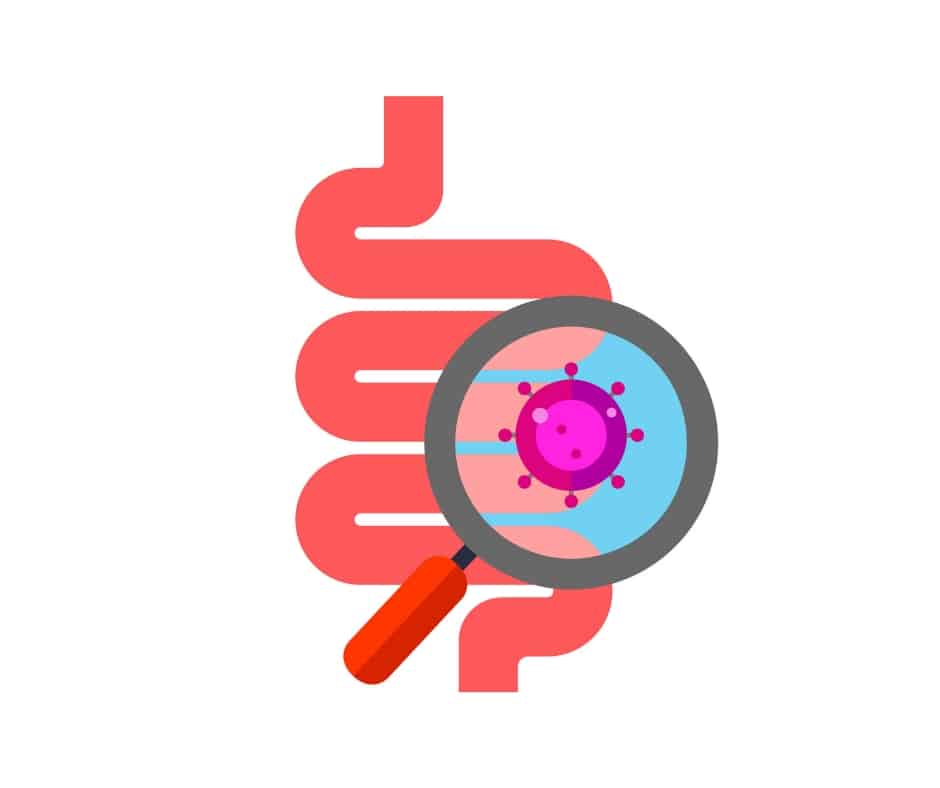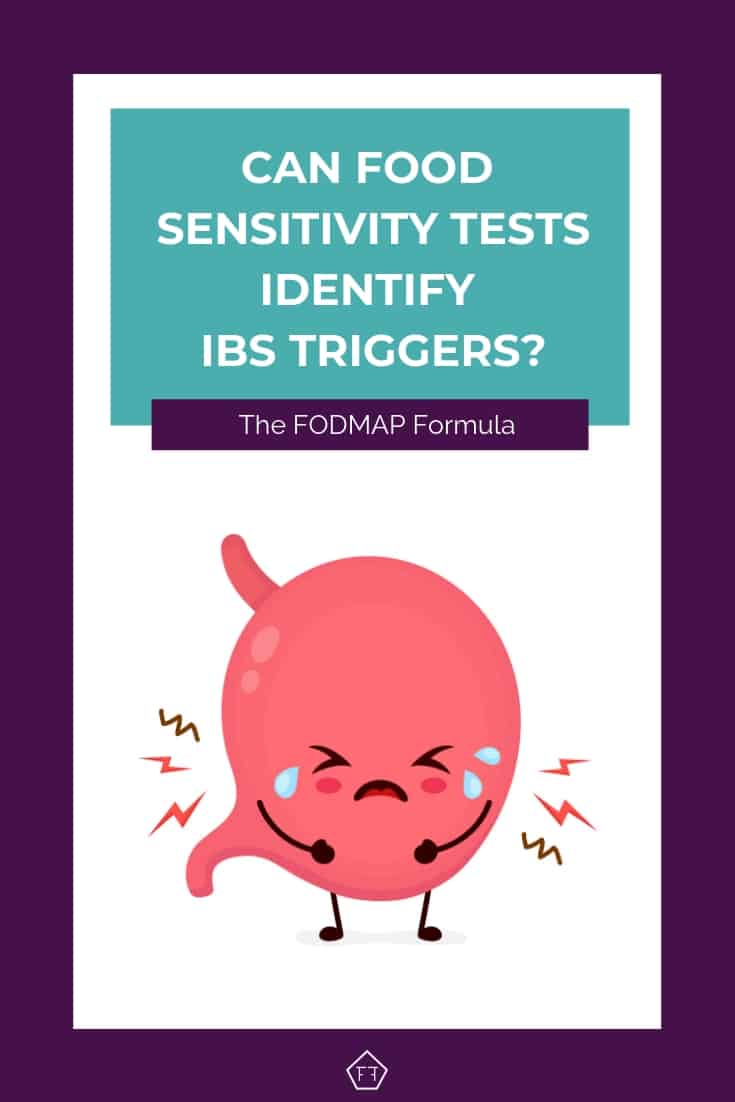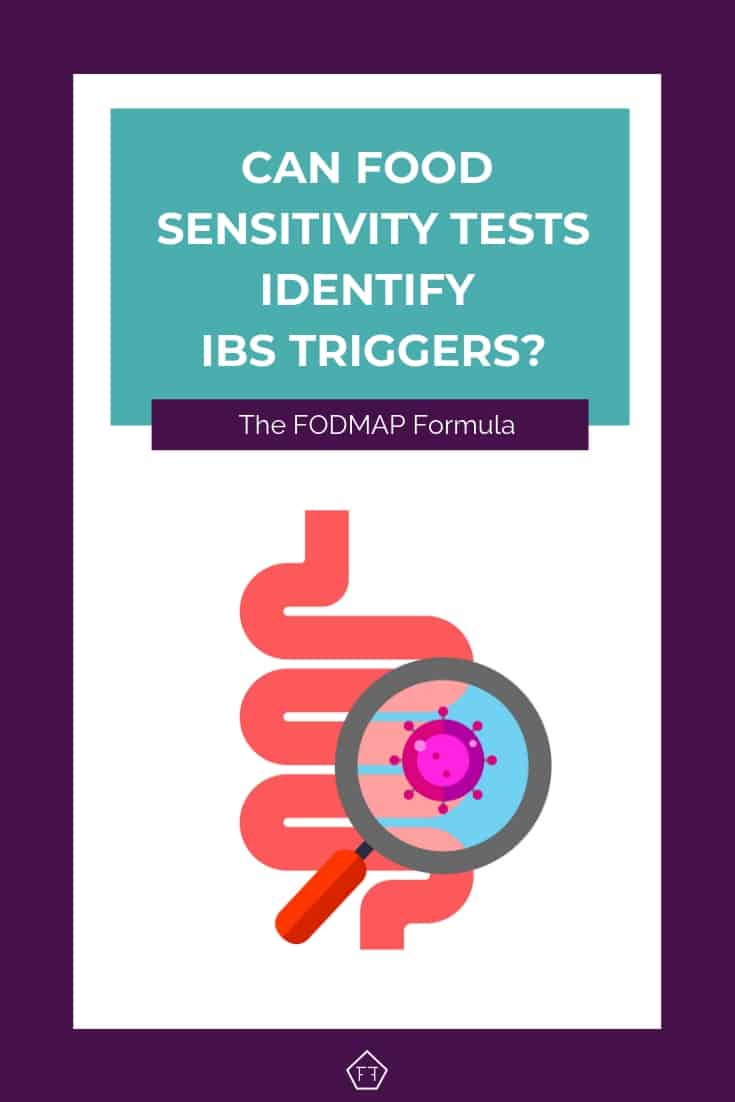Following the low FODMAP diet can be a huge pain in the butt. So, you may be wondering if food sensitivity tests can identify IBS triggers! In this article, we’ll talk about what food sensitivity tests do, how they work, and if they can help you find your dietary triggers.

What’s the Difference Between an Allergy and an Intolerance?
First of all, when we talk about IBS food triggers, we’re talking about food sensitivities, not allergies. So, what’s the difference?
A food allergy is when your immune system reacts to the proteins in everyday food as if it were something that might harm you. According to current research, true IgE-mediated food allergies affect 3.5-4% of the population.
Allergy symptoms may include itching, hives, trouble breathing, tingling or swelling in the lips or mouth, abdominal pain, nausea, vomiting, or diarrhea. If you have any of these symptoms after eating food speak to your healthcare team ASAP! Especially if you’re experiencing these symptoms after eating foods like nuts, seafood, dairy, or eggs.
A food intolerance (or “sensitivity”) happens when foods that should be broken down and absorbed by the body continue to travel through the digestive stem, unabsorbed. As they travel, they may pull water into the bowel and be fermented by gut bacteria. This may lead to painful cramping, bloating, constipation, or diarrhea.
Unlike allergies, reactions caused by an intolerance will resolve as soon as the trigger has exited the digestive system.
How Are Allergies Diagnosed?
If you or your healthcare team suspect a food allergy may be the culprit behind your symptoms, the first thing your doctor should do is review your medical history. If they find evidence that an allergy is likely, they may send you for a skin prick/scratch test or a serologic study to test for allergies. So, what do these tests do?
When your body encounters a protein it doesn’t recognize or that it has mislabelled, it may identify the protein as a threat (damn you pollen!). If your body meets the protein again, it will release a set of antibodies called Immunoglobulin E (IgE). These antibodies are like tattletales that attach to specialized cells in your body. They are called “mast cells” and white blood cells in the bloodstream called “basophil.” Once activated, the mast cells and basophils will begin to release histamine and other inflammatory chemicals. This creates an allergic reaction that starts where you were first exposed (like your mouth, your lungs, or your digestive tract).
In a skin prick/scratch test, a tiny puncture is made in the skin, and a concentrated dose of the allergen is applied directly to the wound. This introduces the allergen directly to your bloodstream. If you do have an allergy, your body will produce a “wheel” around the contact site as your body releases histamine to combat the proteins.
In a serologic study, the presence of specific IgE antibodies is tested in a small sample of blood taken.
While both of these tests can help determine if you have a true allergy, a medically supervised “oral food challenge” is the gold standard in testing for food allergies.
To complete an oral food challenge, you eat the test food in increasing amounts while in a medically supervised environment. The medically supervised environment is key here, friends! So, please don’t try this one at home.

What Are Food Sensitivity Tests?
Commercial food sensitivity tests are modelled after an IgE serologic test. But, instead of looking for the antibody IgE, they look for an antibody called Immunoglobulin G (IgG).
This test is completed by sending a blood or hair sample to a lab or using an at-home finger-prick test to collect a blood sample.
Testing kits typically cost between $300 – $700 and usually test somewhere between 90-100 foods. The tests are available online and through many naturopathic clinics and blood labs in North America.
The Problem with Sensitivity Tests
There are a few things we need to talk about here. First, research shows that our bodies produce the antibody IgG every time we are exposed to certain proteins (whether we react to that food or not). So, while an IgG test can show you what you’ve eaten recently, it can’t necessarily determine if you’re sensitive to that food.
Second, research is starting to show that IgG may actually indicate tolerance to foods, not intolerance. Several studies have shown that as individuals become more tolerant of foods they were previously allergic to, their levels of IgE decrease, and their levels of IgG increase. This may explain why IgG levels are often higher in foods you eat regularly (like your safe foods).
Third, there is currently no scientific body that supports IgG and/or other food sensitivity tests. In 2012, the scientific community’s concern over the use of food sensitivity tests compelled Stuart Carr of the Canadian Society of Allergy and Clinical Immunology (CSACI) to release an official position statement denouncing IgG testing.
In his statement, he stressed that no body of research currently supports IgG testing for the use of predicting food sensitivities. His position is supported by both the American Academy of Allergy Asthma and Immunology and the European Academy of Allergy and Clinical Immunology.
He also confirmed that current research suggests the presence of IgG in a specific food is a marker of exposure and tolerance to that food. Therefore, positive test results for food-specific IgG would be expected in normal, healthy individuals.
Finally, and most importantly, since IgG levels are often the opposite of IgE levels, based on a food sensitivity report, a person with a true allergy may inadvertently add back food they’re allergic to with life-threatening consequences (e.g. a shellfish or tree nut allergy).
Food Sensitivity Tests and IBS
Food sensitivity tests pose a unique problem for people with IBS. As many people have already cut out large groups of foods, fast before leaving the house, or eat as little as possible during the day to avoid triggering their symptoms.
Because IgG testing is basically a grocery list of what you’ve eaten recently, you’ll likely find many of your “safe foods” listed at the top of your food sensitivity reports because that’s what you’re eating regularly.
Now in addition to the emotional upheaval of feeling like no food is safe to eat, food sensitivity tests may lead you to further restrict your diets without any actual benefit to your health. This over-restriction can lead to nutrient deficiencies and malnutrition, as well as lowering your overall quality.
If you need help finding your IBS food triggers, the low FODMAP diet is a short-term program designed to help people with IBS test several common dietary triggers. Research has shown the program helps 3 out of 4 people with IBS reduce their symptoms by up to 75%, so it’s worth investigating with your healthcare team.
Can Food Sensitivity Tests Identify IBS Triggers? Final Thoughts
So can a food sensitivity test helo you identify your food trigger? The short answer is no. If you need help finding your food triggers, save your money and try an elimination diet/re-challenge test (like the low FODMAP program) with your healthcare team.
You might also like one of these:
Is Your Gluten Sensitivity Really an Intolerance to Fructan? Gluten isn’t the only thing in your grains that can turn your tummy! Check out this article to understand the difference between gluten and fructan sensitivity and how to find out which one you’re actually reacting to.
When Should You Start the Low FODMAP Diet? Wondering if you should start the Low FODMAP Diet? Check out this article to find out if the low FODMAP program is right for you and a few things you should try first.
How to Relieve Trapped Gas Need some help letting it go? These practical tips will help you prevent trapped gas when you can and relieve it when it strikes.
If you like this post, don’t forget to share it! Follow me on Instagram @fodmapformula for more tips and recipes that are FODMAP friendly! Together we’ll get the low FODMAP diet down to a science!
References
- Abrams, E. M., & Sicherer, S. H. (2016, October 18). Diagnosis and management of food allergy. Retrieved from http://www.cmaj.ca/content/early/2016/09/06/cmaj.160124.full.pdf html
- Abrams, E. M., & Sicherer, S. H. (2016, October 18). Diagnosis and management of food allergy. Retrieved from http://www.cmaj.ca/content/188/15/1087
- Carr, S., Chan, E., & Lavine, E., Et.al. (2012). CSACI Position statement on the testing of food-specific IgG. Allergy, Asthma, and Clinical Immunology : Official Journal of the Canadian Society of Allergy and Clinical Immunology, 8(1), 12. Retrieved from https://www.ncbi.nlm.nih.gov/pmc/articles/PMC3443017/.
- Choung, R., & Talley, N. (2006). Food Allergy and Intolerance in IBS. Gastroenterology & Hepatology, 2(10), 756-760. Retrieved from https://www.ncbi.nlm.nih.gov/pmc/articles/PMC5358086/?report=reader.
- Food Allergy Vs Food Intolerance in Patients With Irritable Bowel Syndrome. (n.d.). Retrieved from http://www.gastroenterologyandhepatology.net/archives/january-2019/food-allergy-vs-food-intolerance-in-patients-with-irritable-bowel-syndrome/
- Gocki, J., & Bartuzi, Z. (2016). Role of immunoglobulin G antibodies in diagnosis of food allergy. Postepy Dermatologii I Alergologii, 33(4), 253-6. doi:10.5114/ada.2016.61600
- Lavine, E. (2010). Blood testing for sensitivity, allergy or intolerance to food. Canadian Medical Association Journal, 184(6), 666-8. doi:10.1503/cmaj.110026
- Niec, A., Frankum, B., & Talley, N. (1998). Are adverse food reactions linked to irritable bowel syndrome? The American Journal of Gastroenterology, 93(11), 2184-2190. Retrieved from https://www.ncbi.nlm.nih.gov/pubmed/9820394/.
- Sampson, H. (2004). Update on Food Allergy. Journal of Allergy and Clinical Immunology, 113(5), 805-819. doi:10.1016/s0091-6749(04)01145-5
- Stapel, S. O., Asero, R., Ballmer-Weber, B. K., Knol, E. F., Strobel, S., Vieths, S., & Kleine-Tebbe, J. (2008). Testing for IgG4 against foods is not recommended as a diagnostic tool: EAACI Task Force Report. Allergy, 63(7), 793-796. doi:10.1111/j.1398-9995.2008.01705.x


